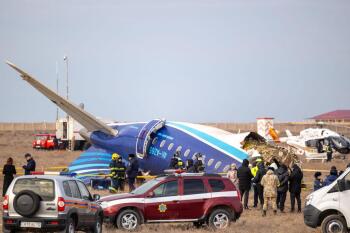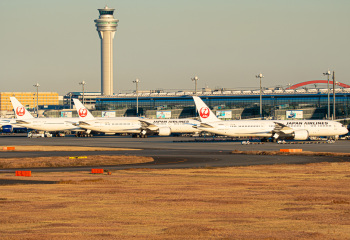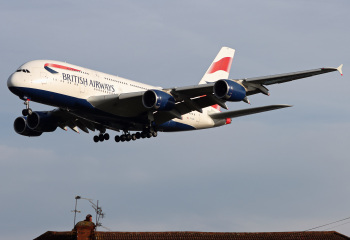With so many commercial airplanes flying in today's skies, it can be difficult to tell them apart, especially when first getting into the hobby. However, it becomes easier to tell aircraft apart by paying attention to the number of engines, aircraft size and shape, landing gear design, and more.
Four-Engine Aircraft
Since the number of engines is the easiest to use as filters for different types of planes, we will start with counting engines first. If the airplane has four engines, it will be a Boeing 707, Boeing 747, Airbus A340, or an Airbus A380. Sadly, four-engine aircraft are disappearing from the passenger market as airlines retire them for more fuel-efficient twin-engine jets. The Boeing 707 is extremely rare to find flying in today's skies, as most airlines have retired the type. It looks like a stretched, narrowbody aircraft with four engines. The landing gear consists of two double bogey sets.
Most similar to the Boeing 707 in terms of appearance is the Airbus A340. While rare, many major airlines such as Lufthansa and Swiss still fly the type. The aircraft has three rows of landing gear sets. The smaller -200 and -300 variants, the middle landing gear set only has a single wheel set, while the larger -500 and -600 variants have an additional double bogey set. Usually, suppose you see a passenger airliner with a single deck consisting of four engines. In that case, it is generally safe to assume it is some variant of the Airbus A340, most likely to either be the -300 or -600 variant.
The Boeing 747 is one of the most well-known and famous aircraft, dubbed "Queen of the Skies." To tell if it's a Boeing 747, just look for a hump above the full-length passenger deck fuselage. Today, the most common passenger variants of the Boeing 747 are the -400 and -8I variants. To tell the difference between these two, the -8I variant has a longer hump compared to the -400 and has chevron-toothed exhaust ducts on its engines. Mostly you will most likely see cargo planes still flying some variant of the Boeing 747, usually consisting of smaller humps.
The Airbus A380 is even easier to distinguish, as it is a full double-decker plane. It also has a bulbous nose with 20 wheels in the rear (2 double bogey sets and 2 triple bogey sets). Like the Boeing 747, the Airbus A380 is well-known outside the aviation geek community due to its distinctive looks.
Three-Engine Aircraft
There are only cargo variants for three-engine aircraft, as airlines have retired these types long ago. You should expect to see the DC-10/MD-11, but the Boeing 727 will also be mentioned. However, there are other three-engine aircraft, such as the Tupolev Tu-154 and the Lockheed L-1011 Tristar.
The Boeing 727 is extremely rare to see today. It consists of the classic Boeing pointed nose that looks very similar to the common Boeing 737. It has three engines at the plane's rear, with one on both the left and right sides and an engine through the tail.
The DC-10/MD-11 is more common than the Boeing 727, as major cargo airliners such as FedEx and UPS still fly the type. Unlike the Boeing 727, this aircraft has only one engine in the rear, which is located below the tail. The other two engines are on both the left and right wing.
Two-Engine Aircraft
As two-engine aircraft are the most popular variants flying today, it can be much harder to tell them apart, as you cannot just use the engine count to filter out aircraft types. However, some variants are easier to distinguish from others, as you can still look for engine placement. It will be organized based on manufacturer type.
Boeing
For Boeing, the Boeing 717 is the easiest twin-engine jet to identify. It has a T-shaped tail with two engines near the tail. It also has a flat tail cone with a more rounded nose. It is the only Boeing variant with engines near the tail instead of under its wings.
The Boeing 737 is one of the most common narrowbodies in service today and has many variants. To identify a Boeing 737, look for a pointed nose, two single landing gear sets, and a triangular dorsal-fin section on the front of its tail. To further separate based on variants, look at the engine exhaust ducts to identify if it's just a regular Boeing 737 or a Boeing 737 MAX. The MAX engines consist of chevron-toothed exhaust ducts, while the regular ones do not. To determine the variant between regular Boeing 737s and Boeing 737 MAX aircraft, just look at how long they are. If it's too hard to figure out with the naked eye, count the number of exit doors or windows for each variant.
The Boeing 757, while out of production, is still common to see in North America. Like the Boeing 737, it is still a narrowbody. However, the first obvious difference is in the nose shape. While the Boeing 737's is pointy, the Boeing 757's nose is more rounded, like a dolphin's. Additionally, it consists of two double-bogey landing gear sets and a V-shaped windshield. To tell if it's a Boeing 757-200 or -300, the -300 is much longer than the -200.
The Boeing 767, like the Boeing 757, is mostly only seen in North America. It consists of a pointed nose and two double-bogey landing gear sets. Essentially, it looks like a larger and wider Boeing 737. To identify if it's a Boeing 777, look for a widebody aircraft with a pointed nose and two sets of triple-bogey landing gears. Just look for size differences to distinguish between the 767 and 777 variants.
The Boeing 787, like the Boeing 757 and 767, has two double-bogey landing gear sets. However, while pointed, the nose is more flat compared to the Boeing 767 and Boeing 777. Also, look for saw-toothed engine housing (similar to the Boeing 737 MAX and Boeing 747-8I) with two curved up (or flexed) wings.
Airbus
The Airbus A300 and A310 variants are very rare to see flying around today. Both widebody aircraft have two double-bogey landing gear sets and a pointed nose. However, the Airbus A300 is longer than the Airbus A310, consisting of three instead of two doors along its fuselage.
The Airbus A320 family of aircraft is very common today, consisting of the Airbus A318, 319, 320, 320NEO, 321, 321NEO, and 321LR. It is used on short- and medium-haul flights, as the 321NEO and 321LR have longer ranges. The Airbus A320 family aircraft have rounded noses and two single-bogey landing gears.
To tell the differences between the Airbus A320 family variants, look for size differences, with the Airbus A318 being the shortest and 321 being the longest. You can also tell by the number of exit doors each variant has. As for the NEO and LR aircraft, see if the engines are wider and bigger than the CEO aircraft. Some airlines may even paint their Airbus A320 and 321NEO aircraft with a racoon-like mask over the windshield.
The Airbus A220 family is also becoming more common today, as it is fuel-efficient. It looks somewhat similar to the Airbus A320 family of aircraft at first glance. However, the key difference lies within its nose shape. Instead of a rounded nose, the nose is more pointed and looks similar to the Boeing 787's.
The Airbus A330 is another widebody aircraft. It consists of a notched windshield, two sets of double-bogey landing gears that are sloped upwards, and often has winglets. Count the number of exit doors or look at the plane's length to identify between the variants. If you want to identify an Airbus A330NEO, the engines are usually bigger, and the windshield is generally painted with a raccoon-like mask.
The Airbus A350 is quite easy to distinguish from the Airbus A330. It has curved winglets and a less pointy nose than the Airbus A300, 310, and 330. Additionally, the windshield shape is curved and has a racoon-like mask. As for distinguishing between the variants, the -800 and -900 have two sets of double-bogey landing gears, while the longer -1000 variant has two sets of triple-bogey landing gears.
CRJ and ERJ
The CRJ and some ERJ variants are similar at first glance to the Boeing 717 as they also have two engines near their tail. However, the CRJ's nose is pointy. To tell which CRJ variant it is, just look at its size or count the number of windows. The ERJ 135 and 145 are the Embraer variants with engines at the rear. However, it seems different from the CRJs and Boeing 717, as its pointy nose is sloped out from under its windshield.
The ERJ variants with wing-mounted engines are the 170, 175, 190, and 195. All three look similar, with pointy noses similar to the CRJ variants. The E190 and 195 are easy to distinguish from the 170 and 175, as it is significantly longer than them. As for telling the differences between the 170 and 175, it is much harder, as both look similar in size to the naked eye. However, if you count the windows, you'll find your difference (18 for the 170 and 20 for the 175).
This is a brief guide to spotting some of the most common commercial jets. As you spot more, it will become easier to identify small details that distinguish each aircraft type.
South African Airways Eyes India–South Africa Route » Ethiopian Airlines Expands Fleet with Second Airbus A350-1000 » Japan Airlines Systems Back to Normal After Cyberattack Caused Holiday Flight Disruptions »
Comments (0)
Add Your Comment
SHARE
TAGS
INFORMATIONAL Boeing Airbus Technical AircraftRECENTLY PUBLISHED
 Missile Strike Confirmed as Cause of Azerbaijan E190 Crash
Azerbaijani government sources have confirmed that a Russian Pantir-S1 surface-to-air missile was the cause of the Embraer E190 crash on Christmas Day.
NEWS
READ MORE »
Missile Strike Confirmed as Cause of Azerbaijan E190 Crash
Azerbaijani government sources have confirmed that a Russian Pantir-S1 surface-to-air missile was the cause of the Embraer E190 crash on Christmas Day.
NEWS
READ MORE »
 3 Shot, 1 Stabbed After Alleged Christmas Day Family Dispute at Phoenix Skyharbor Airport
Four people were found injured at Phoenix Skyharbor Airport after a family dispute that violently escalated on Wednesday night.
NEWS
READ MORE »
3 Shot, 1 Stabbed After Alleged Christmas Day Family Dispute at Phoenix Skyharbor Airport
Four people were found injured at Phoenix Skyharbor Airport after a family dispute that violently escalated on Wednesday night.
NEWS
READ MORE »
 Japan Airlines Systems Back to Normal After Cyberattack Caused Holiday Flight Disruptions
Japan Airlines (JAL) said on Thursday that its systems were back to normal after an alleged cyberattack crippled its servers and halted ticket sales. This comes only days after American Airlines, one of JAL's partners, experienced a crippling Christmas Eve ground stop.
NEWS
READ MORE »
Japan Airlines Systems Back to Normal After Cyberattack Caused Holiday Flight Disruptions
Japan Airlines (JAL) said on Thursday that its systems were back to normal after an alleged cyberattack crippled its servers and halted ticket sales. This comes only days after American Airlines, one of JAL's partners, experienced a crippling Christmas Eve ground stop.
NEWS
READ MORE »





